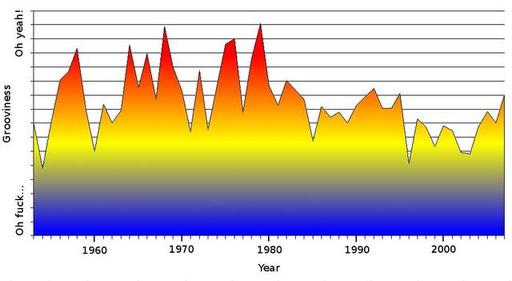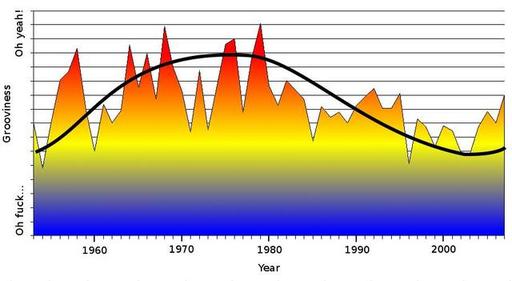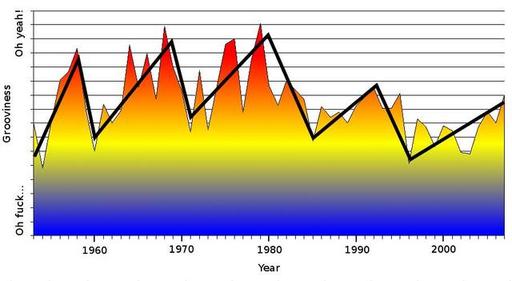Living on the Neener-Net
I guess it makes sense if you think of how the religion got started
"Ass frequency" is now a meaningful scientific term
Silly Sword Fights
Recent Results in Groovology
I recently turned my attention back to groovology, in an attempt to find a scientific answer to
an age-old question: who was the greatest band of all time? There are
lots of opinions out there, of course, but unlike those musical
pundits, I have data. Hard, hard data, and the numbers never lie.
I tried numerous formulae to aggregate the grooviness data for
various artists, and finally settled on a formula that rewards not
quantity nor quality, but quantity of quality. Furthermore, the formula
punishes producers of inane drivel. A band with 3 consistently good #1
hits can outscore a band with 6 number ones of varying quality, and
both will outscore a band with 9 hits that were pure drivel. The basic
method is to sum the grooviness quotient for all of the band's #1
tunes, adjusted so that drivel counts as negative groove. The median
score ("tolerably bland") is slightly positive, so a high number of
hits should, on average, count as positive groove. For reference, a
score of 100 is equivalent to 2 holy-shit-that-was-awesome number 1
hits, or 10 meh-that-was-okay-but-ultimately-forgettable number 1
hits. Since this measures quantity of quality, this is really a
measure of how good the artist was at making good music, and not a
direct measure of the quality of the music itself.
On to the results, then. The 25 grooviest acts of all time are shown below. Aggregate grooviness scores are shown; ties are broken using average grooviness (this favours artists that make fewer but better #1 hits over artists that churn out more, but blander #1 tunes).
- Beatles (640)
- Elvis Presley (270)
- Abba (220)
- Rolling Stones (210)
- Blondie (200)
- U2 (180)
- Eminem (160)
- Madonna (160)
- Kinks (130)
- Police (130)
- Slade (120)
- Frankie Goes to Hollywood (110)
- Louis Armstrong (100)
- Queen (100)
- Oasis (100)
- Connie Francis (90)
- David Bowie (90)
- Mud (90)
- Shadows (90)
- Pet Shop Boys (80)
(tie) Guy Mitchell (80) - Everly Brothers (80)
(tie) All Saints (80)
(tie) Rod Stewart (80) - Manfred Mann (70)
(tie) John Lennon (70)
(tie) Gary Glitter (70)
(tie) Lonnie Donegan (70)
The Beatles took the #1 spot, by a shockingly large margin. Rumours of them being the greatest band ever appear to be confirmed. Elvis, who is also claimed to be the greatest rock-and-roller ever, actually had more #1 hits (23 to the Beatles' 18), but he also churned out a huge amount of drivel, which negatively impacted his overall rating. Abba turned in a surprisingly good performance at #3; they weren't musically great (not even making the top 10 in terms of average song grooviness) but they were very consistent, and they cranked out more #1 hits than the Stones, who came in at #4. Eminem beat Madonna for the #7 spot, on account of achieving a grooviness score of 160 with only six #1 hits, whereas Madonna's blander music required twelve #1's to achieve the same score. The Kinks got to #9, right below Madonna, on the strength only three songs.
Some other interesting facts:
- Elvis' score was inflated because of a string of posthumous #1 hits in 2005, which were re-releases of previous hits. Removing these from his results pushes him down to 5th place.
- With one formula for measuring anti-grooviness (average grooviness of the artists worst #1 songs, not shown here), Elvis is also #2 on the worst artist of all time list. This is because the sheer volume of Elvis' #1 hits means he also has one of the largest numbers of bad #1 hits. The Beatles did not have this problem.
- Although the Stones have put out albums in every decade since the 1960s, all of their #1 hits were in the 1960s. Their grooviness rating is based entirely on those 60's hits.
- Not counting Elvis' posthumous hits, the only artists on this list with hits in 3 separate decades are Blondie, U2, and Madonna.
We can attempt to normalize the grooviness of the band by dividing their score by the number of hits. This basically removes quantity from the above equation, allowing us to compare the actual grooviness of the music, rather than the artists' ability to produce grooviness. To exclude one-hit wonders, I only considered acts with at least 3 #1 hits. In this case, our top-10 are:
- Kinks
- Frankie Goes to Hollywood
- Beatles
- Blondie
- David Bowie
(tie) Connie Francis
(tie) Mud - Rolling Stones
- U2
- Abba
Interestingly, this list contains only two American acts, both with female leads - Blondie and Connie Francis. The other eight are European, 6 from the UK, one Irish, and one Swedish. This is partly due to the data being UK #1 hits, of course. But it's not that Americans are under-represented: Elvis has 23 #1 hits in this data set, more than any other artist. But when we normalize grooviness, Elvis falls to a distant 35th place. The UK acts are more consistently groovy--the British Invasion was not for nothing.
If we reduce the threshold for inclusion to artists with at least 2 #1 hits, the top spot is taken over by Louis Armstrong. Other acts that sneak onto the bottom of the list are New Seekers, Outhere Brothers, Don Maclean, and Duran Duran.
Most Overrated Acts of All Time
We can apply the same general approach for determining the most overrated acts of all time. If we set a limit of at least three #1 hits to be considered for the title of most consistently awful hit musical act, we arrive at the following list:
- Westlife (-40)
- Ronan Keating (-30)
- Gerry & The Pacemakers (-30)
- George Michael (-20)
- Bee Gees (-10)
- Gareth Gates (-10)
- Peter Andre (-10)
- Cliff Richard (0)
- B*Witched (0)
- Robson & Jerome (0)
(tie) S Club 7 (0) - Elton John (10)
(tie) Boyzone (10) - Usher (10)
(tie) Steps (10)
(tie) Jason Donovan (10)
(tie) Donny Osmond (10)
(tie) David Cassidy (10)
For the record, I was a bit surprised that George Michael and Elton John appeared on this list, since they have both produced music that I like. But none of their better stuff made it to #1, apparently, so it's not in my data set. The UK public preferred different stuff than I did, and man was it awful. Really awful.
Also-rans
For the record, here are all the artists who are best at producing #1 hits, but who are neither groovy nor awful, in order of number of hits. This can be interpreted as a list of the most mediocre acts of all time.
- Spice Girls (10)
- Take That (9)
- Kylie Minogue (6)
- Michael Jackson (6)
- Frankie Laine (5)
(tie) Britney Spears (5)
(tie) Robbie Williams (5)
Google's business model explained

The Theory of Grooviness
So I recently had the opportunity to go through a list of every #1 hit in the UK from 1952 until 2007 -- over 1100 of them. At first I wanted to separate the good from the bad, to make a short(er) list of music I'd be interested in. So I dutifully rated every song according to a quantitatively precise and scientifically robust system invented by... me. Each song got a grooviness rating from 1 to 5:
- Oh god, I hope I never have to listen to that ever again.
- Intolerably bland. Ick.
- Tolerably bland. Hm, what? There's music playing?
- Pretty good actually. Who is that playing?
- Oh yeah.
But after completing this onerous task, I realized that I had an interesting data set: over 1100 data points of grooviness versus date. It's unclear exactly what this data set measures in aggregate, but I think it is one of the following:
- the quality of pop music over time (if you assume that #1 hits are a reliable indicator of musical quality)
- the taste of UK music consumers over time (if you assume that #1 hits are a reliable indicator of the sophistication of the typical pop music fan)
- the skill of record promoters (this would be in inverse relation to the song quality, on the assumption that bland music reaching #1 is largely due to corporate manipulation of the public taste)
- my deep and unspecified personal biases. However, for the record, I have no specific genre bias, and I did my best to listen with fresh ears and rate songs by their objective grooviness, and not by the cringe factor brought on by decades worth of overplay by wedding DJs. The Village People, Michael Jackson, and Madonna were treated as if they were fresh young stars, and not tired old hacks who make me want to throw up a little.
With 15-30 #1 songs per year, the simplest analysis was to compute the average grooviness by year, and then graph it to look for interesting trends.

I propose the following two theorems of pop music. Proof will follow.
Theorem 1:
Music from before you were born is dorky and lame.
Theorem 2:
After you become a productive adult, the music of "kids these days" is idiotic and lame.
If these theorems are correct, the smoothed chart of grooviness should show a distinct bell curve, peaking at some point during my youth. Let's see what the data has to say:

The graph speaks for itself. I consider these two theorems proven beyond any reasonable doubt. Surprisingly, the peak of grooviness is in 1977, a year that I would not otherwise have singled out as being particularly groovy. I mean, seriously: Abba and Boney M at the all-time peak of grooviness? But correlation is not causation, so perhaps Blondie and Pink Floyd had a little more to do with the late '70s being the grooviest years of all time. By the way, I consider this to be evidence that I have kept my personal biases from influencing the data too strongly, otherwise the 1980s (my high school and university years, when I actually followed pop music) should surely have scored better. On the other hand, perhaps the '80s really were as dumb as they now seem.
Curiously, however, the data shows that the idiocy of modern pop exceeds the dorkiness of classic pop. This might have something to do with the fact that the grooviness of Frank Sinatra has withstood the test of time, whereas the purported grooviness of 'Nsync and Westlife have yet to be tested.
Here's another widely posited theorem that has never been quantitatively proven until now:
Theorem 3:
Music has a distinct character in each decade. '80s music is different from '70s music, which is distinct from '60s music. Etc.
Let's look at our chart to see if we can detect any 10-year cycles or patterns that might back up this thoerem:

Not only does the data support the theorem, but the pattern itself is very interesting: grooviness has a natural sawtooth pattern, peaking in the last years of each decade. It's pretty much common knowledge that the pop-culture movements collectively known as "the Sixties" were really just the years 1967-68, with '69 being the hangover. This data supports the idea that the same cultural effect occurs in each decade. That's why the '50s are associated with Elvis and tailfins on cars, and why the '70s are associated with big collars and bell-bottoms.
Why is culture (as reflected in pop music) comparatively lame in the early years of each decade, and notably awesome in the last? I hypothesize that it is a decade-level variant of the millennial effect on people's need to celebrate. As decades come to a close, a certain desperation for change takes over the popular consciousness, allowing truly innovative works to percolate up to general popularity. In the early years of a decade, by contrast, there is a sense that the future is here, leading to a general sense of self-satisfaction and mediocrity. For now we will identify this phenomenon as the "Party-Like-It's-1999" Effect, or PLINE. (You heard it here first.) Unfortunately PLINE implies that next year is likely to suck it big.
Arguing against the PLINE hypothesis is that the absolute peaks of grooviness seem to occur in years ending in 8, not 9. Also, the PLINE effect is weakest in 1999, the year when you would expect it to be strongest. In fact, the chart suggests that culturally speaking, the 1990s didn't actually happen at all, and we more or less threw out the whole decade and merged it with the noughties. Perhaps genuine millennial anxiety threw us off. After all we were already starting to get a little worked up in the 1980s—the chart suggests that it took us until 1984 to completely put the 1970s behind us, and that the 80's actually peaked in 1992.
Edit: I've been thinking more about PLINE theory, and realized something significant: the fact that grooviness peaks in years ending in 8 is actually an important feature of the data, not an unexpected weakness of the theory. Years ending in 9 seem to be on the cusp of the future—we are almost there, so to speak—so cultural mediocrity gets a head start. If you scale up this "Party-Like-It's-1998" Effect to the century level, it suggests that the all-time peak of grooviness would be around 1980. The charts support this analysis, with the highest peak of groove occurring in 1979.
For what it's worth, I was more than a little surprised that the 1990s were basically a no-show in grooviness. I distinctly remember than the 1990s actually put out some damn good music, certainly better than what I was consuming during the 1980s. But it appears that comparatively little of the damn good music made it to #1. I think my correction to PLINE theory adequately explains this anomaly.
Mobu on YouTube
Does this mean I'm famous now? Good thing I'm wearing a mask...
Zork on crack
CFL WTF

But apparently I just dreamed the whole thing up. It never happened. I went to a news source that would surely have something to say about a venerable Canadian sporting tradition, the good ol' CBC. But their front page (see below) was mysteriously mute on the subject.
Never mind, the CBC is a serious news source, right? Obviously it's all in the sports section. So I click through to the sports page, but mysteriously, they have nothing important to say about the Grey Cup. The main stories are about some random regular season NHL dreck. (See below).
Okay, well, obviously the CBC has decided that the Grey Cup is a special interest story, important only to a few oddballs out in the fringes, and has buried it all on their Football page. So I click there. Nothing. (See below if you don't believe me.)
I kid you not. The lead story on the Football page of CBC news, on the day after the craziest Grey Cup in recent memory, is something to do with the NFL.
W. T. F.
New Fencing Instructional Video
There's nothing like a bit of boogy while getting stabbed to death.
Manifest
Things that mobu likes, things that mobu does, things that mobu makes, things that mobu thinks.